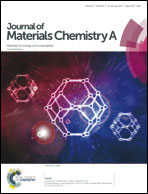Low-temperature growth of polyethylene glycol-doped BiZn2VO6 nanocompounds with enhanced photoelectrochemical properties
Abstract
We demonstrate scalable, low-cost and low-temperature (<100 °C) aqueous chemical growth of bismuth–zinc vanadate (BiZn2VO6) nanocompounds by BiVO4 growth on ZnO nanobelts (NBs). The nanocompounds were further doped with polyethylene glycol (PEG) to tune the electronic structure of the materials, as a means to lower the charge carrier recombination rate. The chemical composition, morphology, and detailed nanostructure of the BiZn2VO6 nanocompounds were characterized. They exhibit rice-like morphology, are highly dense on the substrate and possess a good crystalline quality. Photoelectrochemical characterization in 0.1 M lithium perchlorate in carbonate propylene shows that BiZn2VO6 nanocompounds are highly suitable as anodes for solar-driven photoelectrochemical applications, providing significantly better performance than with only ZnO NBs. This performance could be attributed to the heterogeneous catalysis effect at nanocompound and ZnO NB interfaces, which have enhanced the electron transfer process on the electrode surface. Furthermore, the charge collection efficiency could be significantly improved through PEG doping of nanocompounds. The photocurrent density of PEG-doped BiZn2VO6 nanocompounds reached values of 2 mA cm−2 at 1.23 V (vs. Ag/AgCl), over 60% larger than that of undoped BiZn2VO6 nanocompounds. Photoluminescence emission experiments confirmed that PEG plays a crucial role in lowering the charge carrier recombination rate. The presented BiZn2VO6 nanocompounds are shown to provide highly competitive performance compared with other state-of-the art photoelectrodes.



 Please wait while we load your content...
Please wait while we load your content...